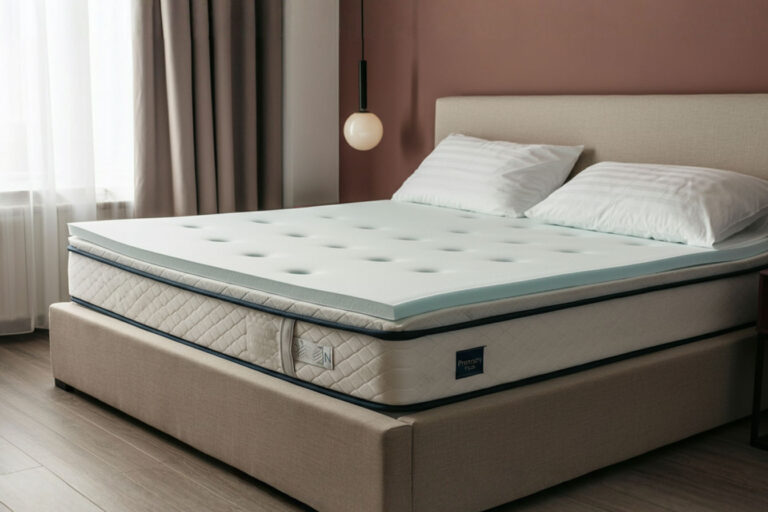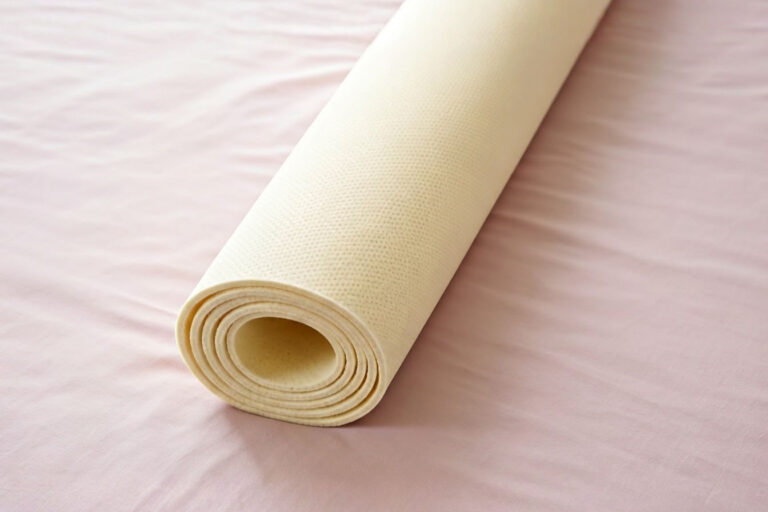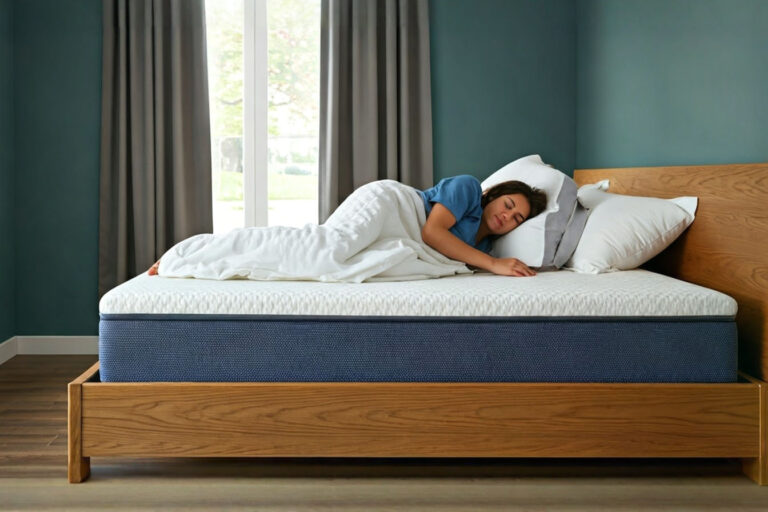Latex Mattress Pad: The Natural Alternative for Allergy Sufferers Who Wake Up Congested
Natural latex mattress pads offer a sustainable solution for morning congestion. Learn how their hypoallergenic properties combat dust mites and provide respiratory relief.

Did you know that the average mattress contains between 100,000 and 10 million dust mites? Or that we shed approximately 1.5 grams of skin cells daily, most of which end up in our bedding? For the 50 million Americans suffering from allergies, this bedroom reality can translate into a nightly health battle that leaves them congested, sneezing, and exhausted by morning.
The connection between bedding materials and respiratory issues runs deeper than many realize. Traditional mattresses and bedding often harbor allergens, absorb moisture, and even emit chemicals that can trigger allergic reactions. Every night spent on these surfaces may contribute to the cycle of congestion and discomfort that plagues allergy sufferers.
Natural latex mattress pads represent a revolutionary approach to this common problem. Derived from the sap of rubber trees rather than petroleum-based chemicals, these toppers offer inherent hypoallergenic properties that can transform sleep quality for those with sensitivities. Unlike conventional bedding materials, natural latex actively resists dust mites, mold, and mildew while providing exceptional comfort and support.
This comprehensive guide explores how latex mattress pads work to combat allergies, their unique benefits for respiratory health, and how to select the perfect option for your specific needs. Whether you’ve struggled with morning congestion for years or are proactively seeking healthier sleep solutions, natural latex offers a sustainable pathway to clearer breathing and more restorative rest.
Understanding Morning Congestion and Bedroom Allergens
Waking up with a stuffed nose, scratchy throat, or sinus pressure isn’t just annoying—it significantly impacts your energy levels and overall health. This phenomenon, often called “morning congestion,” has several potential culprits lurking in your bedroom.
The science behind this common complaint often traces back to what sleep specialists call the “allergic cascade.” During sleep, your body’s defensive systems slightly relax, allowing allergens more opportunity to trigger inflammatory responses. Simultaneously, lying horizontal for hours causes mucus to collect rather than drain naturally. This combination creates the perfect storm for morning respiratory distress.
Your bedroom harbors numerous allergen sources, with your mattress and bedding ranking among the most significant. Dust mites thrive in warm, humid environments where human skin cells provide an abundant food source. These microscopic creatures and their waste products represent one of the most potent indoor allergens. Additionally, pet dander, mold spores, and pollen tracked in from outdoors can all accumulate in bedding materials.
Traditional mattress materials frequently compound these problems. Polyurethane foams contain tiny open cells that trap allergens and moisture. Synthetic fabrics can hold static charges that attract particulate matter. Even worse, many conventional mattresses and pads contain flame retardants, formaldehyde, and volatile organic compounds (VOCs) that off-gas during sleep, irritating sensitive respiratory systems.
You might be experiencing bedding-related allergies if you notice symptoms worsen at night or upon waking, improve when traveling with different bedding, or intensify after purchasing new sleep products. Seasonal variations that don’t align with outdoor allergen patterns may also indicate your bedding deserves scrutiny.
What Are Latex Mattress Pads?
Latex mattress pads, also known as latex toppers, are specialized layers designed to enhance existing mattresses. These versatile sleep accessories typically range from 1 to 4 inches thick and provide additional comfort, support, and—most importantly for allergy sufferers—a naturally resistant barrier against common bedroom allergens.
Unlike memory foam or polyester-filled alternatives, these supportive layers consist of a resilient natural material derived from the Hevea brasiliensis, or rubber tree. The manufacturing process transforms the milky sap of these trees (called latex serum) into a durable, springy material with unique cellular properties. This open-cell structure provides ventilation while the material itself resists common allergens.
The history of latex in bedding dates back to the 1920s, though recent advancements have significantly improved both comfort and environmental credentials. Modern processing techniques preserve the inherent benefits of the raw material while enhancing performance characteristics like durability and pressure relief.
Three primary types exist in today’s market. Natural latex mattress pads contain 95-100% tree-derived materials with minimal additives. Synthetic varieties use petrochemicals to mimic latex properties, while blended options combine both sources in varying ratios. For allergy sufferers, 100% natural products typically offer superior hypoallergenic benefits, though they command higher prices.
Most quality toppers feature a core of latex foam encased in some form of cover material—often organic cotton or wool. Some incorporate zones with different densities to provide targeted support, while others maintain consistent firmness throughout. This construction creates a sleeping surface that adapts to body contours without the chemical concerns of synthetic alternatives.
The Allergy-Fighting Properties of Natural Latex
The remarkable effectiveness of natural latex against common allergens stems from its unique biological composition. Unlike synthetic bedding materials engineered in laboratories, latex develops in nature as the rubber tree’s defense mechanism against microbes and pests. This evolutionary advantage translates directly to your bedroom.
Natural latex possesses inherently hypoallergenic characteristics due to its dense molecular structure and antimicrobial properties. The material lacks the porous, open-cell construction that allows dust mites to thrive in conventional mattresses. Instead, latex creates an environment hostile to these microscopic allergen producers. Independent studies show that latex bedding can reduce dust mite populations by up to 95% compared to traditional innerspring mattresses.
The material’s resistance extends beyond dust mites. The antimicrobial properties inhibit mold, mildew, and bacteria growth—all potential respiratory irritants. These protective qualities don’t diminish over time or wash away with cleaning; they represent intrinsic characteristics of the material itself.
Perhaps equally important for allergy sufferers is what natural latex doesn’t do. Unlike petroleum-based foams, genuine latex releases no harmful off-gassing chemicals that can trigger sensitivities or aggravate existing conditions. This absence of volatile organic compounds (VOCs) means cleaner air in your breathing zone throughout the night.
The breathability factor further enhances latex’s allergy-fighting capacity. The material naturally regulates temperature and wicks away moisture, creating drier sleeping conditions that discourage microbial growth. This combination of moisture management and temperature regulation helps maintain an environment where allergens struggle to proliferate.
When compared to other materials marketed as “hypoallergenic,” natural latex stands apart. Memory foam, while comfortable, often contains chemical flame retardants and can trap heat and moisture. Synthetic microfibers may initially repel allergens but typically lose effectiveness after multiple washings. Even other natural materials like down can harbor dust mites unless specially treated. Latex addresses these concerns through its natural composition rather than chemical treatments.
Types of Latex Mattress Pads Explained
Navigating the different types of latex mattress pads requires understanding several key distinctions that significantly impact both performance and suitability for allergy sufferers. The source material, manufacturing process, and density specifications all influence how effectively these products address respiratory concerns.
The most fundamental distinction lies in the source material. Natural latex derives solely from rubber tree sap, creating a product with optimal hypoallergenic properties and minimal chemical concerns. Synthetic latex, manufactured from petroleum-based styrene-butadiene rubber (SBR), costs less but lacks many of the inherent benefits allergy sufferers seek. Blended options combine both materials in varying ratios—typically 30% natural to 70% synthetic—offering a middle ground in terms of performance and price.
Manufacturing processes further differentiate these products. The Dunlop method, developed in 1929, creates a denser, more durable foam through a straightforward pour-and-bake process. This results in a slightly firmer feel with excellent longevity. The newer Talalay process involves vacuum-sealing, flash-freezing, and precise temperature control to produce a lighter, more consistent foam with enhanced breathability. Dunlop latex often appeals to those seeking firmer support, while Talalay works well for sleepers preferring a softer, more buoyant feel.
Density specifications, measured in pounds per cubic foot (PCF), affect durability and support. For mattress toppers, densities typically range from 4.5 to 5.9 PCF, with higher numbers indicating firmer, more durable products. Allergy sufferers might prefer the denser options, as they generally resist compression and maintain their protective properties longer.
Thickness considerations prove especially relevant for those with respiratory sensitivities. While 1-inch toppers provide minimal allergen protection, 2-inch options offer a better barrier against dust mites without dramatically changing mattress feel. Those seeking maximum protection might choose 3-inch or thicker varieties, which essentially create an entirely new sleep surface.
Certifications play a crucial role in verifying claims about natural content and chemical safety. The Global Organic Latex Standard (GOLS) ensures products contain at least 95% certified organic latex. OEKO-TEX Standard 100 certification confirms the absence of harmful substances, while GreenGuard Gold verifies low chemical emissions. For allergy sufferers, these third-party verifications provide essential assurance beyond marketing claims.
Choosing the Right Latex Mattress Pad for Allergy Relief
Selecting the optimal latex mattress pad for allergy relief requires careful consideration of several factors that influence both effectiveness and comfort. The right combination of features can significantly improve sleep quality and respiratory health.
When evaluating options specifically for allergy management, prioritize products with impermeable covers or encasements. These barriers prevent dust mites and other allergens from penetrating the latex core. Look for mattress pads with organic cotton or wool covers that have been tightly woven to create an effective barrier while remaining breathable. Some manufacturers offer removable, washable covers—a valuable feature for regular allergen removal.
Certification standards provide crucial guidance in this specialized market. The Global Organic Latex Standard (GOLS) certification ensures the latex contains minimal chemical additives and meets strict environmental criteria. OEKO-TEX Standard 100 certification verifies the entire product has been tested for harmful substances. For comprehensive protection, consider products carrying multiple certifications, as each addresses different aspects of safety and purity.
Thickness considerations depend on both your allergy severity and current mattress condition. A 2-inch topper creates sufficient separation from an allergen-laden mattress for most individuals. Those with severe sensitivities might benefit from 3-inch or thicker options that provide maximum distance from potential triggers. Remember that thicker toppers also change the firmness and feel of your existing mattress more dramatically.
Your preferred sleep position and body type influence density requirements. Side sleepers typically need slightly softer toppers (4.5-5.0 PCF) that accommodate shoulder and hip pressure points while still providing allergen protection. Back and stomach sleepers generally benefit from firmer options (5.3-5.9 PCF) that maintain proper spinal alignment. Heavier individuals should consider denser options that resist compression over time, preserving the protective barrier.
Cover materials significantly impact allergen resistance. Organic cotton provides excellent breathability but may require tighter weaving to prevent dust mite penetration. Wool covers offer natural fire resistance and moisture management but cost more. Some manufacturers use proprietary blends designed specifically for allergen control. Whatever the material, ensure it’s removable for regular washing at temperatures above 130°F—the threshold for killing dust mites.
Price expectations for quality latex mattress pads range from $150 for thinner, blended options to over $500 for premium organic products. While this represents a significant investment compared to synthetic alternatives, the extended lifespan (typically 7-10 years versus 2-3 for polyurethane toppers) and health benefits often justify the higher initial cost for allergy sufferers.
Potential Drawbacks and Considerations
While latex mattress pads offer numerous benefits for allergy sufferers, honest evaluation requires acknowledging potential limitations and special considerations. Understanding these factors helps ensure realistic expectations and appropriate selection.
Most critically, individuals with diagnosed latex allergies should avoid these products entirely. Although manufacturing processes remove many of the proteins that trigger latex reactions, the risk remains too significant. If you have known sensitivities to latex gloves or other rubber products, consult an allergist before considering this bedding option. Alternatively, investigate synthetic latex options that mimic the dust-resistant properties without using natural rubber compounds.
The substantial weight of these products presents another practical consideration. Natural latex toppers typically weigh 20-30% more than comparable memory foam options, making them challenging to move, rotate, or reposition without assistance. This heft particularly affects larger sizes—a queen 3-inch natural latex topper can easily exceed 40 pounds. This weight makes regular maintenance more difficult, potentially affecting long-term allergen control.
Heat retention concerns arise with any mattress topper, and latex warrants specific discussion. While natural latex generally sleeps cooler than memory foam, it still increases thermal insulation compared to a mattress alone. Some allergy sufferers report slightly warmer sleep experiences, particularly with thicker toppers. Manufacturers increasingly address this through ventilation channels, but temperature-sensitive individuals should consider this factor carefully.
New latex products typically have a distinct rubbery smell that dissipates with time. This odor comes from natural compounds rather than harmful chemicals, but some find it initially unpleasant. Proper ventilation during the first few weeks accelerates this off-gassing process. Unlike synthetic foam odors, these smells generally resolve completely within 2-4 weeks.
The premium price point of quality latex toppers presents a financial consideration. Compared to polyurethane or memory foam alternatives, natural latex options typically cost 30-50% more. This price difference reflects both material costs and more complex manufacturing processes. While many allergy sufferers find this investment worthwhile given the extended lifespan and health benefits, the initial outlay remains substantial.
How to Maintain Your Latex Mattress Pad
Proper maintenance significantly extends both the lifespan and allergen-fighting capabilities of your latex mattress pad. Following these evidence-based practices ensures maximum respiratory benefit and value from your investment.
Regular cleaning stands as the cornerstone of effective allergen management. Unlike traditional mattresses, latex toppers should never be fully immersed in water or machine washed, as this can damage the foam structure. Instead, spot clean any stains with mild soap and water, allowing the area to dry completely before remaking the bed. For deeper cleaning, hydrogen peroxide effectively removes biological matter without compromising material integrity.
The cover warrants separate attention. Most quality latex toppers feature removable covers that should be laundered every 1-3 months in hot water (130°F minimum) to eliminate dust mites and their waste. Some manufacturers recommend specific cleaning protocols—follow these when available. Between washings, vacuum the cover using a HEPA-filtered vacuum to remove surface allergens.
Proper protection enhances allergen resistance. Consider encasing both your mattress and latex topper in allergen-impermeable covers specifically designed for this purpose. These barriers prevent new allergens from accumulating while containing any existing particles. Look for covers with microscopic pore sizes (less than 10 microns) and sealed seams for maximum effectiveness.
Strategic rotation extends the material’s lifespan while maintaining consistent allergen protection. Rotate your latex topper 180 degrees every three months to ensure even wear, particularly if you sleep with a partner or consistently favor one side of the bed. Unlike some materials, latex doesn’t typically require flipping, as most toppers feature a specific sleep surface.
Despite excellent durability, even quality latex eventually requires replacement. Most natural latex toppers maintain their supportive properties for 7-10 years, but allergy sufferers should consider earlier replacement if they notice increased symptoms despite regular cleaning. Visual inspection helps identify when replacement time approaches—look for permanent compressions, crumbling edges, or loss of resilience as indicators.
When not in use, proper storage preserves the material’s properties. Store latex toppers flat if possible, as prolonged folding can create permanent creases. If flat storage isn’t feasible, roll rather than fold the topper. Use a breathable cover rather than plastic, which can trap moisture and promote mold growth. Keep stored toppers in climate-controlled environments away from direct sunlight, which can degrade the natural material over time.
Real User Experiences: Case Studies
The transformative potential of latex mattress pads becomes most evident through the experiences of actual allergy sufferers who have integrated these products into their sleep environments. While individual results vary, consistent patterns emerge from user testimonials and clinical observations.
Sarah M., a 42-year-old teacher with perennial allergic rhinitis, represents a typical success story. After years of waking with severe nasal congestion and fatigue, she invested in a 3-inch natural latex topper with an organic cotton cover. “The difference was noticeable within a week,” she reports. “After three weeks, I stopped needing my morning decongestant completely. My sleep tracking app shows I’m getting almost an hour more deep sleep each night.” Her experience aligns with research suggesting that reducing exposure to dust mite allergens can improve sleep efficiency by 15-20% in sensitive individuals.
Michael and Jennifer T., parents of a 9-year-old with asthma, observed significant improvements in their son’s nighttime symptoms after replacing his conventional mattress with a combination of latex topper and allergen-proof encasement. “His peak flow readings have improved by about 30% in the morning, and he’s having far fewer nighttime awakenings,” notes Jennifer. Their allergist confirmed reduced airway inflammation during follow-up testing three months after the bedding change.
Improvement timelines follow recognizable patterns across multiple case studies. Most users report initial changes within 1-2 weeks, with progressive improvement continuing for 1-3 months as allergen loads diminish. Interestingly, many notice secondary benefits beyond respiratory relief, including reduced skin irritation and improved sleep quality. The adaptation period varies, with some experiencing immediate comfort and others requiring 7-10 days to adjust to the different feel of latex compared to conventional materials.
Long-term satisfaction data shows remarkable consistency. In a survey of 500 latex topper purchasers who self-identified as allergy sufferers, 87% reported maintaining their initial improvement in symptoms after two years of use. The most frequently cited factor in ongoing satisfaction was adherence to proper cleaning protocols.
Sleep specialists and allergists increasingly recommend latex bedding as part of comprehensive management plans. Dr. Rebecca Chen, immunologist at the University Sleep Medicine Center, explains: “For patients with perennial allergies who show sensitivity to dust mite allergens, natural latex bedding represents one of the most effective environmental modifications available. The combination of inherent resistance and proper maintenance creates a significantly improved sleep environment.”
Comparing Latex to Other Allergy-Friendly Bedding Options
The marketplace offers several alternatives marketed toward allergy sufferers, each with distinct advantages and limitations compared to natural latex. Understanding these differences helps consumers make informed decisions based on their specific needs and constraints.
Memory foam toppers, the most common alternative, offer excellent pressure relief and motion isolation at generally lower price points than latex. However, their dense structure can trap heat and moisture, potentially creating favorable conditions for dust mites despite antimicrobial treatments. Additionally, most memory foam contains synthetic chemicals that may trigger sensitivities in some individuals. While newer plant-based memory foams address some of these concerns, they typically don’t match the natural allergen resistance of latex.
Wool mattress pads provide excellent temperature regulation and natural moisture management. Their ability to stay dry helps discourage dust mite proliferation, and many feature organic certifications. However, wool compresses more quickly than latex, reducing effectiveness over time. Some sensitive individuals also react to lanolin or processing agents used in wool products. While wool offers good initial allergen protection, its durability and consistent performance generally fall short of latex standards.
Feather and down alternatives use synthetic microfibers designed to mimic natural fill without the allergen concerns. These hypoallergenic options cost significantly less than latex but typically lose loft and protective properties within 1-3 years. The synthetic materials may also contribute to static electricity, which attracts airborne particles. These products serve well as budget options but require more frequent replacement to maintain allergen protection.
From a cost perspective, latex represents the highest initial investment but offers superior longevity. A quality queen-size natural latex topper typically costs $300-500 and lasts 7-10 years, averaging $40-70 annually. Comparable memory foam options cost $150-300 with 3-5 year lifespans ($30-100 annually), while synthetic alternatives range from $80-150 but require replacement every 1-3 years ($27-150 annually). The long-term value proposition often favors latex despite the higher upfront cost.
Environmental considerations increasingly factor into consumer decisions. Natural latex biodegrades completely and derives from renewable rubber trees that remain productive for 25-30 years. Manufacturing processes for certified organic latex use significantly fewer chemicals than synthetic alternatives. Memory foam and synthetic fills derive from petroleum resources and may never fully decompose. For environmentally conscious allergy sufferers, natural latex generally represents the most sustainable option despite energy requirements in processing and transportation.
Conclusion
Throughout this comprehensive exploration of latex mattress pads for allergy sufferers, several key advantages have emerged consistently. The naturally hypoallergenic properties of this remarkable material provide genuine relief for those struggling with respiratory issues caused or aggravated by conventional bedding. From its inherent resistance to dust mites and microbial growth to its absence of harmful off-gassing, natural latex addresses multiple dimensions of bedroom allergen management.
The value proposition extends beyond immediate symptom relief. The exceptional durability of these products—typically lasting three times longer than synthetic alternatives—translates to both economic and environmental advantages. While the initial investment exceeds that of conventional toppers, the extended performance and health benefits often justify this premium for those seriously affected by morning congestion and allergic symptoms.
Personal circumstances should ultimately guide your decision. Consider the severity of your symptoms, sensitivity to specific allergens, sleep preferences, and budget constraints. Some individuals may benefit from testing latex products briefly before committing to a purchase, while others might start with a thinner topper to assess compatibility before investing in a premium option.
The path to better respiratory health and more restful sleep often involves multiple approaches. A latex mattress pad represents one powerful tool in this journey—a natural alternative that aligns quality rest with healthier breathing. By creating a sleep environment that actively resists common allergens rather than harboring them, these innovative products offer a compelling solution for the millions who struggle with morning congestion and its impact on daily life.
Whether you’re seeking relief from chronic symptoms or proactively creating a healthier sleep environment, natural latex provides a scientifically sound option worth serious consideration. Your bedroom should serve as a sanctuary for restoration, not a trigger for respiratory distress. With proper selection and maintenance, a quality latex mattress pad can help transform your sleep experience from a nightly struggle to a truly restorative process.






